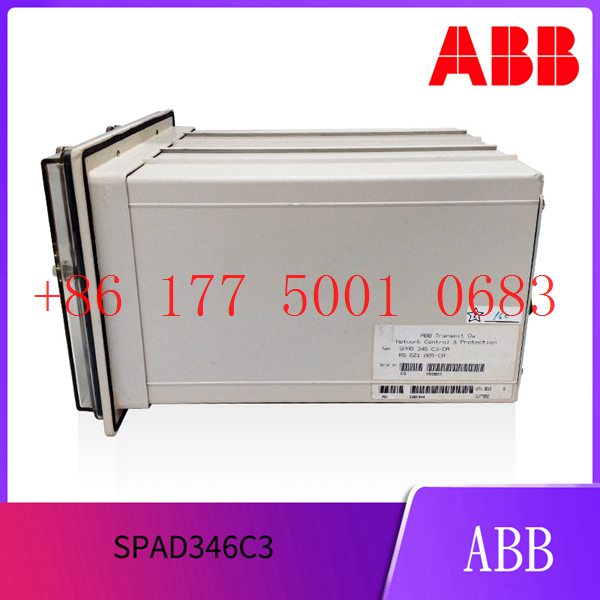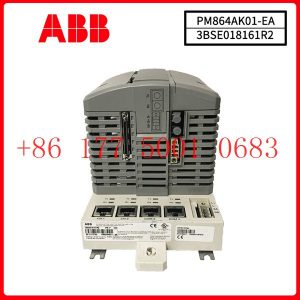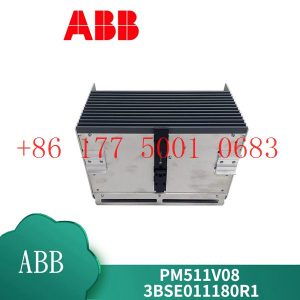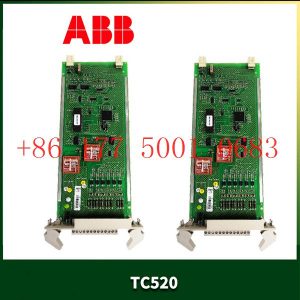Description
hardware flow control. It is an ideal choice in the field of industrial automation.
Design and implementation of variable frequency transmission system based on ABB hardware architecture
introduction
With the increasing development of transmission technology and the increasing demand for actual use, variable frequency transmission systems have been widely used.
As a Fortune 500 company in the world, ABB is a leader in the fields of power and automation technology and has strong capabilities in control
systems, high-voltage, medium-voltage and low-voltage frequency conversion technology and transmission technology. Therefore, this article mainly
relies on ABB”s control, frequency conversion and transmission technology, and uses related hardware products to design and implement the frequency conversion transmission system.
To truly design and implement a usable variable frequency drive system, the entire system must be fully equipped, conveniently operable and
compatible with a wide range of needs, so that it can be used without changing the control method and operation. According to the actual control needs,
that is, combining frequency converters with different performances and variable frequency motors with different speeds or torques to quickly build and realize a variety of control requirements.
1 System design purpose and composition
The design purpose of this system is to control ABB inverters through local and remote control methods and complete 4 independent channels
of closed-loop speed control to drive different test objects to rotate.
The entire control system consists of the following four main components: remote control computer, panel industrial computer (touch screen),
PLC and speed-regulating frequency converter. The system design block diagram is shown in Figure 1.
In order to ensure the accuracy of motor speed control, an encoder module is added. The PLC can obtain the feedback of the rotary encoder in the
frequency converter through the ProfibusDP protocol. The speed control is performed through the frequency converter for internal PID closed-loop control.
2 System hardware implementation
2.1 Control some hardware
The control part of the hardware mainly refers to the sum of hardware that supports operators to use the equipment directly or indirectly and complete
the functions of the equipment. Its main hardware includes computer control terminal, touch screen control terminal, PLC control unit, other auxiliary
circuits and measurement and control components.
2.2 Transmission hardware
The transmission hardware mainly refers to the total number of equipment that can relatively independently perform a complete transmission function.
Its main hardware includes frequency converters, variable frequency motors (configured with rotary encoders as needed) and other auxiliary circuits.
Among them, the selection of motors and frequency converters should be based on the principle of selecting the motor first and then selecting the
frequency converter. details as follows:
First, according to the tangential speed at which the object under test is to complete rotation, select the motor speed according to the following formula:
Secondly, choose based on several other important basic parameters of the motor, such as system hardness, torque, weight, etc
. This system uses ABB”s variable frequency motor.
Finally, select an appropriate frequency converter based on the motor power. In addition, the actual situation of the object being tested must also be taken
into consideration, such as whether the rotating load belongs to the heavy-load usage of the frequency converter, etc.
3Software system
System software includes three major categories in total, namely computer control software, touch screen software and PLC software. Among them, the PLC software, as the
underlying software, is responsible for the interaction with the computer control software and touch screen software on the upper side, and the interaction
with the frequency converter on the lower side. Therefore, from the architecture of the entire software system, it can be defined as a host and slave computer structure.
3.1 System development platform
The software system has two control methods: remote and local. The development platforms for the three major categories of software are Windows operating system,
LabVIEW[4] integrated development environment, CodesysV2.3, and CP400.
3.2 System software architecture
The software of the entire system is divided into three types, namely remote control software, PLC control software and local control software. Among them,
the remote control software runs under the Windows operating system and is developed under the LabVIEW integrated development environment; the PLC control software is
developed under the CodesysV2.3 programming environment; the local control software runs on the touch screen computer and is developed under the CP400 environment.
The relationship between the three software is shown in Figure 2.
Display operation panel PFSK164
Display operation panel PFSK162 3BSE015088R1
Display operation panel PFSK162
Display operation panel PFSK160A 3BSE009514R1
Display operation panel PFSK160
Display operation panel PFSK152 3BSE018877R1
Display operation panel PFSK152 3BSE018877R1
Display operation panel PFSK152
Display operation panel PFSK151 3BSE018876R1
Display operation panel PFSK151 3BSE018876R1
Display operation panel PFSK151
Display operation panel PFSK142 3BSE006505R1
Display operation panel PFSK130 3BSE002616R1
Display operation panel PFSK102
Display operation panel PFSA146 3BSE008844R1
Display operation panel PFSA145 3BSE008843R1
Display operation panel PFSA140 3BSE006503R1
Display operation panel PFSA140 3BSE006503R1
Display operation panel PFSA140
Display operation panel PFSA103D
Display operation panel PFSA103C
Display operation panel PFRL101D-5KN
Display operation panel PFRL101D 5.0KN
Display operation panel PFRL101D
Display operation panel PFRL101C
Display operation panel PFRL101B-1.0KN
Display operation panel PFRL101B
Display operation panel PFRL101A-0.5KN 3BSE023314R0003
Display operation panel PFRL101A
Display operation panel PFRA101 3BSE003911R230
Display operation panel PFRA101
Display operation panel PFPA201 3BSE022827R1
Display operation panel PFPA201
Display operation panel PFEL113
Display operation panel PFEL112
Display operation panel PFEL111
Display operation panel PfeifferTPR280
Display operation panel PFEA113-65 3BSE050092R65
Display operation panel PFEA113-65 3BSE050092R65
Display operation panel PFEA113-65 3BSE028144R0065
Display operation panel PFEA113-65
Display operation panel PFEA113-65
Display operation panel PFEA113-20 3BSE050092R20
Display operation panel PFEA113-20 3BSE028144R0020
Display operation panel PFEA113-20
Display operation panel PFEA113
Display operation panel PFEA112-65 3BSE050091R65
Display operation panel PFEA112-65 3BSE030369R0065
Display operation panel PFEA112-65
Display operation panel PFEA112-20 3BSE050091R20
Display operation panel PFEA112-20
Display operation panel PFEA112-20
Display operation panel PFEA112
Display operation panel PFEA111-65 3BSE050091R65
Display operation panel PFEA111-65 3BSE050090R65
Display operation panel PFEA111-65 3BSE050090R65
Display operation panel PFEA111-65 3BSE028140R0065
Display operation panel PFEA111-65
Display operation panel PFEA111-65
Display operation panel PFEA111-65
Display operation panel PFEA111-20 3BSE050090R20
Display operation panel PFEA111-20 3BSE050090R20
Display operation panel PFEA111-20 3BSE028140R0020
Display operation panel PFEA111-20 3BSE028140R0020
Display operation panel PFEA111-20
Display operation panel PFEA111-20
Display operation panel PFEA111
Display operation panel PFEA101
Display operation panel PFCL301E
Display operation panel PFCL201CE-20KN
Display operation panel PFCL201CE
Display operation panel PFCL201C/CD
Display operation panel PFCL201C 10KN
Display operation panel PFCL201C 5KN 3BSE027070R5
Display operation panel PFCL201C 20KN
Display operation panel PFCL201C 10KN
Display operation panel PFCL201C









Reviews
There are no reviews yet.